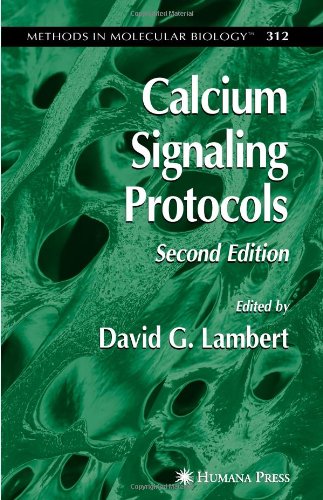

Most ebook files are in PDF format, so you can easily read them using various software such as Foxit Reader or directly on the Google Chrome browser.
Some ebook files are released by publishers in other formats such as .awz, .mobi, .epub, .fb2, etc. You may need to install specific software to read these formats on mobile/PC, such as Calibre.
Please read the tutorial at this link: https://ebookbell.com/faq
We offer FREE conversion to the popular formats you request; however, this may take some time. Therefore, right after payment, please email us, and we will try to provide the service as quickly as possible.
For some exceptional file formats or broken links (if any), please refrain from opening any disputes. Instead, email us first, and we will try to assist within a maximum of 6 hours.
EbookBell Team

4.1
60 reviews
ISBN 10: 161737573X
ISBN 13: 978-1617375736
Author: David G. Lambert
In the first edition of Calcium Signaling Protocols I began by writing “The regula- 2+ tion of intracellular Ca is a common theme presented in many papers over the last 20 2+ or so years and the description of the Ca -sensitive indicator dye fura-2 in 1985 resulted in a massive increase in these types of studies. ” This statement is as true in 2005 as it was in 1999, but 20 or so years is now 30 years! There has been some reorganization of the volume such that there are now 22 ch- ters including five new ones, all written by experts in their field. These new chapters 2+ include use of the FlexStation and electrophysiological measurement of Ca channel activity. The book is broken into six parts. Part I is a general coverage of basic theory and the simplest use of fluorescent indicators. Part II covers specialist measurement 2+ systems and Part III covers measurement of Ca channel activity. Assessment of 2+ release of stored Ca is covered in some detail in Part IV, with Parts V and VI cover- 2+ ing specialist measurement techniques and Ca -sensitive targets. Putting a book like this together, even as a second edition, takes time and I am, again, indebted to the individual authors for their help and patience. I am also very grateful to Professor John M. Walker, the series editor, for his continued help and advice over the course of this project.
Fluorescent Measurement of [Ca²⁺]c
Measurement of [Ca²⁺]i in Whole Cell Suspensions Using Fura-2
Measurement of [Ca²⁺]i in Cell Suspensions Using Indo-1
Confocal Microscopy
Single-Cell and Subcellular Measurement of Intracellular Ca²⁺ Concentration
Ratiometric Ca²⁺ Measurements Using the FlexStation® Scanning Fluorometer
Measuring Ca²⁺ Changes in Multiwell Format Using the Fluorometric Imaging Plate Reader
Measurement of Ca²⁺ Entry Using ⁴⁵Ca²⁺
Measurement of [³H]PN200-110 and [¹²⁵I]ω-Conotoxin MVIIA Binding
Whole-Cell Patch Clamp Recording of Voltage-Sensitive Ca²⁺ Channel Currents
Measurement of Phospholipase C by Monitoring Inositol Phosphates Using [³H]Inositol-Labeling Protocols in Permeabilized Cells
Measurement of Inositol(1,4,5)Trisphosphate Using a Stereospecific Radioreceptor Mass Assay
Measurement of Calcium Fluxes in Permeabilized Cells Using a ⁴⁵Ca²⁺ Uptake and Release Assay
Microinjection of myo-Inositol(1,4,5)Trisphosphate and Other Calcium-Mobilizing Agents Into Intact Adherent Cells
Measurement of Free [Ca²⁺] Changes in Agonist-Sensitive Internal Stores Using Compartmentalized Fluorescent Indicators
Measurement of [Ca²⁺]i in Smooth Muscle Strips Using Front-Surface Fluorimetry
Measurement of Calcium and Movement in Heart Cells
Simultaneous Analysis of Intracellular pH and Ca²⁺ From Cell Populations
Measurement of Cytosolic-Free Ca²⁺ in Plant Tissue
Assay and Purification of Calmodulin-Dependent Protein Kinase
Assay and Purification of Calmodulin-Dependent Cyclic Nucleotide Phosphodiesterase and Isozyme Separation
Measurement of Ca²⁺-ATPase Activity (in PMCA and SERCA1)
calcium signaling in plants
calcium signaling pathways
calcium signaling protocols
what is calcium signalling
calcium cell signaling
Tags: David Lambert, Calcium, Signaling, Protocols